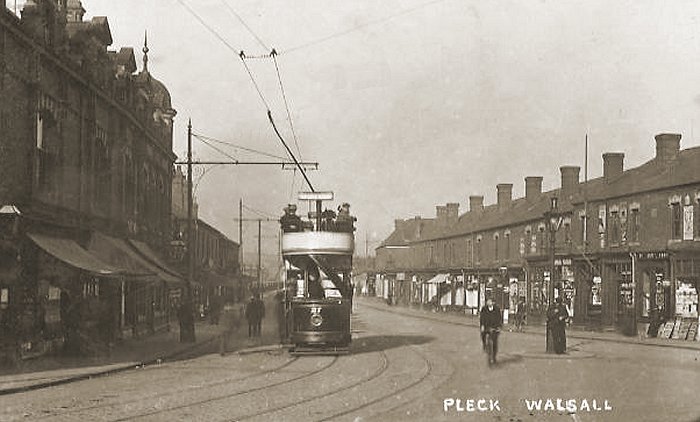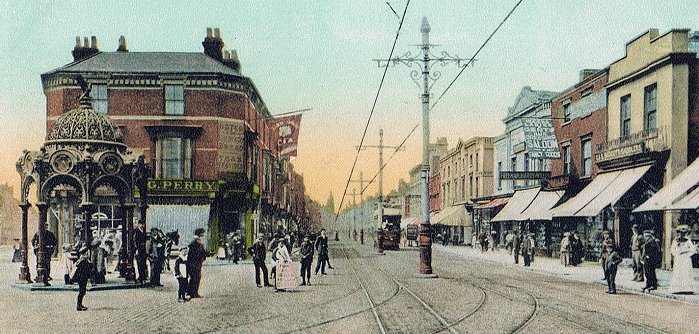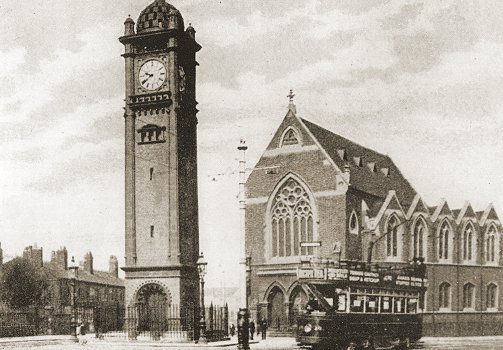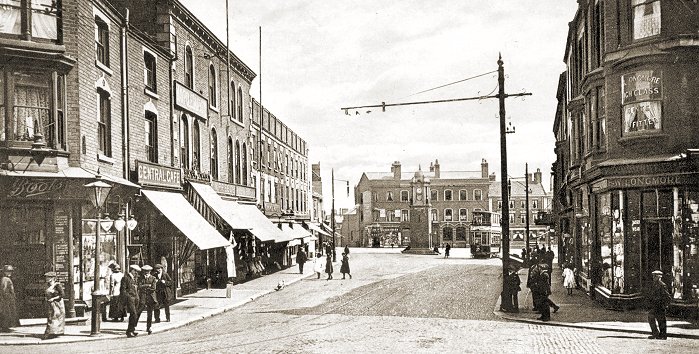| The
South Staffordshire Tramways (Lessee) Company Limited. |
|
A Rocky Road
Walsall Corporation
Walsall
Corporation was first to acquire some of the South
Staffordshire lines. In July 1899 the Corporation applied to
the Board of Trade to obtain permission to compulsorily
purchase the tramways within the Borough. The Corporation
also gave South Staffs Tramways, six months' notice of its
intention to terminate the agreement made in February 1892
which allowed the company to electrify the lines within the
Borough. This would require the company to remove all the
electrical equipment including poles and overhead wires.
On 23rd
November, 1899 an agreement was signed between Walsall
Corporation and South Staffs Tramways Company Limited (with
the agreement of BET and the Lessee company) for the sale of
the tramways within the Borough to the Corporation. Except
for Birchills depot, Pleck generating station, and the
tramcars. The Corporation paid £18,500 for the tramways, and
immediately withdrew the six months' notice to terminate the
1892 agreement. The threat of the termination had been
enough to ensure that the company would agree to the
Corporation's terms.
Walsall
Corporation obtained the necessary powers to purchase or
lease, and operate the existing tramways in the Borough, and
extend them by about eleven miles, under the terms of the
Walsall Corporation Act, 1900.
|
|

From an old postcard. |
|
On 1st
January, 1901 the Act came into effect, and the company
continued to run the trams as before, but now under a three
year's lease to the Corporation. Building work quickly began
on an extension to the Bloxwich route, and the Corporation
asked for extra tramcars on the various routes to provide a
more frequent service. The capacity of the Corporation's
electricity generating station was increased, along with the
building of a tramway transformer station in Hospital
Street. Around May 1892 the operating voltage on the
Bloxwich route was increased from 350 to 500 volts, and new
tramcars were introduced on the route. They were based at the Birchills depot. The old 350 volt trams continued to operate
on the other lines, still powered by the Pleck generating
station. The new Bloxwich line opened on 13th December, 1902
after a successful Board of Trade inspection.
Walsall
Corporation's Tramways Committee decided that from November
1901 all routes would start from The Bridge, and in October
1902 a Sunday service would start to operate on the route to
Mellish Road, which seems to have only lasted for a few
weeks. The following services operated by the end of 1902:
|
The Bridge to Bloxwich: 7½
minutes and 15 minutes service at different times of
the day.
The Bridge to Wednesbury: 15 minutes service.
The Bridge to Darlaston: 15
minutes and 30 minutes service at different times of
the day. |
|
| Around the beginning of 1903 all of the old 350 volt
tramcars were converted to 500 volt operation, and on 16th
May 1903 a new service began to operate from The Bridge to
Bilston via Darlaston, and Moxley over Wolverhampton
Corporation's line. The fare was
3½ pence, but the
service only ran for a few months. Walsall Corporation
replaced the track to Mellish Road which was badly worn,
doubled the track in Park Street, and added four tracks and
a central island at The Bridge, as a new terminus. Many
other sections of the tramway had been improved by the time
the three year lease with the South Staffs company expired.
Walsall Corporation then completely took over the routes in
the Borough, commencing operation on 1st January, 1904,
after an official opening ceremony on 31st December. |
|

The reconstructed lines and
central island on The Bridge, Walsall. From an old postcard. |
| West Bromwich Corporation West
Bromwich Corporation decided to take up the option to
compulsorily purchase and operate all the lines within the
Borough, and to get permission to purchase and operate
several lines outside the Borough. In order to get the
necessary powers to proceed, the Corporation had to get a
Bill through Parliament. When it came under consideration by
a House of Commons select committee, objections were raised
from the South Staffordshire Tramways Company who greatly
objected to the purchase of their lines outside the Borough.
The Bill was then modified to include only the purchase of
the lines within the Borough, and passed as the West
Bromwich Corporation Act, 1900.
Negotiations then took place between the Corporation and
BET which resulted in an agreement on 31st December, 1900.
This enabled the Corporation to purchase all of the lines
within the Borough including those of the Birmingham and
Midland companies, reconstruct and electrically equip them,
then grant leases to the prospective companies for a period
of twenty one years. The Corporation paid £32,000 for the
South Staffs lines, which were just over five miles in
length. The purchase took effect on 31st December, 1901.
The Corporation then made an agreement with BET for the
company to reconstruct the whole of the Corporation's lines
at a cost not exceeding £100,000. Work got underway rather
slowly and caused severe disruptions to the steam trams,
which resulted in many complaints. Centre poles and double
tracks were used
on the main part of the route through the town centre as far
as the Handsworth boundary. When this section had been
completed, in about August 1902, the Corporation approached
Handsworth Urban District Council to ask if the new tramway
could be joined to existing tramway in Handsworth to allow
through steam working. Handsworth UDC would not allow any of
the existing track to be disturbed, so in the end, the
Corporation had to re-lay part of the new track to join the
old track at the boundary, which further added to the
delays. The new tramway had been constructed by George Law
of Kidderminster. On Monday
8th December, 1902 the new line was energised from the
Corporation's power station at Black Lake, which
provided 500 volts DC. On the same day a trial run
was made from the Handsworth border to Carter's Green and back
with one of the new, recently purchased tramcars. A
successful Board of Trade inspection was carried out on 9th
December by Mr. A. P. Trotter, and Colonel Yorke.
The opening ceremony, performed
by the Mayor, took place on Friday 19th December, 1902, and
the new service began immediately afterwards from the
Woodman Inn on the Handsworth boundary to Carter's Green.
By this time, eight of the eighteen tramcars ordered from
the Brush Electrical Engineering Company, at Loughborough
had arrived. They were sufficient in number to provide a five minutes
service on the section of line then in use. This worked well
until the first Saturday football match at The Hawthorns.
Extra steam trams were on hand to cope with the large
numbers of fans, but they were largely ignored, people
preferred the new electric tramcars which rapidly became
overcrowded. The extra steam trams became a necessity on
match days, and continued to be used for some time. |
|

The double track and centre poles
in West Bromwich High Street. From an old postcard. |
|
The new electrically operated
service was reliable and popular, the only inconvenience
being the necessity to change to a steam tram at the
Handsworth border. Another snag was that the Hockley depot,
where the trams were housed, was just over the Handsworth
border and so the trams had to be towed between the
electrified line and the depot by steam locomotive.
The electrification programme
continued at a fast pace. By January 1903 the line from
Carter's Green to Great Bridge had been completed. It opened
for service on 24th January. The first section of the line
from Carter's Green to Hawkes Lane, Hill Top opened on the
19th February, 1903, the remainder to Wednesbury via
Holloway Bank opened on 10th April.
After the opening of the
electrified West Bromwich to Dudley line in May 1903,
special cars were run as far afield as Kinver, and on match
days at The Hawthorns, from Cradley, Stourbridge, and
Kingswinford. In November of that year, two new sections of
electrified line opened along Spon Lane and Bromford Lane.
On 5th March, 1904, Handsworth Urban District Council
finally agreed to purchase the tramways within the Borough
and pay £5,250 for the track and depot. The sale excluded
the steam engines and cars. In April a contract for the
reconstruction and electrification of the Handsworth lines
was placed with George Holloway of Wolverhampton. The work
proceeded quickly and had been completed by early August,
but electric trams could not run because of yet more
disagreements between the company and West Bromwich and
Handsworth councils. Although the electric tramcars had
been running in West Bromwich for some time, the lease had
not been paid and over £8,000 was owed. This was settled on
8th September when the company paid the arrears. The other
sticking point was electricity. The electric power for the
Handsworth line would initially come from the West Bromwich
power station, until Handsworth could provide its own. The
amount the company would have to pay Handsworth for
electricity when available, had not yet been decided, so
electric tramcars could not run on the Handsworth line until
the matter was resolved. |
|

A tram at Carter's Green. From
an old postcard. |
Not to be beaten, the company powered up the
Handsworth section early on the morning of 10th
September and had a trial run on the line.
Handsworth Council was furious because the lease
had not been completed.
The connections were removed, the line short
circuited, and a steam roller was placed at right
angles across the track to ensure that no trams
could use the route. |
The council also sent a letter to the tramway company
informing them that there would be no further interference
with Handsworth's lines, and that if an undertaking was not
received from the company to that effect, by the following
Wednesday, damages would be claimed, and a court injunction
would be obtained. On 19th September the two sides finally
started talking, and the lease was soon completed. The tram
service finally started to operate on 1st October. |
| Tipton Urban District Council
The council initially decided to promote a Bill in
Parliament to enable it to compulsorily purchase and operate
the tramways within the Borough. Talks then followed with
BET, Birmingham & Midland, and South Staffs companies, after
which the council decided to drop the Bill. In exchange the
companies agreed to pay a lump sum plus £150 for thirty
years, and electrically equip the tramways, and pay the
council's costs for promoting the Bill.
On 25th April, 1902 Tipton Urban District Council wrote to
the South Staffordshire Tramways (Lessee) Company suggesting
that a tramway should be built from Great Bridge Market
Place, along New Road, and Toll End Road to join the
Wednesbury to Tipton line at Ocker Hill. This led to the
tramway company promoting a Bill which included the proposed
tramway. Unfortunately a disagreement arose between the
company and the council, and so the proposal was removed
from the Bill. |
| Darlaston Urban District Council
Darlaston Council decided not to exercise its right of
compulsory purchase of the tramlines within the Borough. |
| Wednesbury Borough Council Wednesbury Borough Council
agreed to compulsorily purchase the tramways within the
Borough and lease them to the company, under the terms of
South Staffordshire Tramways Act, 1900. A provisional
agreement was made with the company in 1901 for the sale of
all the lines except Darlaston to Moxley, and Darlaston to
James Bridge, because both lines ran along roads where the
boundary between the towns was along the centre of the road.
This meant that parts of the lines were in Wednesbury
and parts in Darlaston.
Darlaston Urban District
Council approved the plans to electrify the line from the
Bull Stake, Darlaston to Moxley in January 1902, and work
began soon afterwards. Wednesbury Council then complained
that the work had been carried out without consent because
the tramway ran on the Wednesbury side of the western end of
Moxley Road, and Moxley High Street. The disagreement
continued for a long time and held-up the negotiations about
the granting of the lease. The council threatened legal
action against the company, and threatened to oppose the
forthcoming Bill that was being promoted by the company. It
would require Wednesbury Council to lease the lines to the
company, should it decide to take up its
option of compulsorily purchasing the company's lines in the
Borough.
|
|

A tram proceeds through
Wednesbury Market Place. From an old postcard. |
|
Discussions began between
the council and the company, each making offers and
counter-offers. The differences appeared to have been
settled when agreement was reached on 15th April, 1903 to
lease all the tramways in the borough to the company, except
for the disputed lines from Darlaston. By this time the
Darlaston-Moxley line had been completed and inspected by
the Board of Trade, but more disagreements followed over the
purchase and leasing of Darlaston depot and the tramcars.
The argument continued for a long time. Agreement was not
reached until May 1906. |
 |
|
 |
|
 |
|
Return to
Formation |
|
Return to the
S. Staffs menu |
|
Proceed to
The
Company Matures |
|